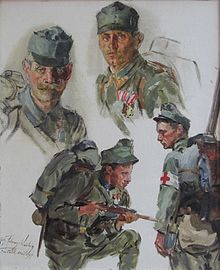Fritz Schwarz-Waldegg
Fritz Schwarz-Waldegg , actually Friedrich Schwarz (born March 1, 1889 in Vienna , † September 4, 1942 in the Maly Trostinez extermination camp near Minsk ) was an Austrian painter .
Life
Schwarz-Waldegg was born in Vienna as the fourth child of Jewish parents who supported his artistic talent. At the age of seventeen he was able to attend David Kohn's private painting school. At the age of 27 , Schwarz-Waldegg converted to the Catholic faith , which was easily approved by his family.
He received his further training at the Vienna Academy of Fine Arts under Christian Griepenkerl and Rudolf Bacher . As a young artist, he got to know Egon Schiele and Oskar Kokoschka . Subsequently, Schwarz-Waldegg became a member of the liberal artists' association Hagenbund , in which neither religious beliefs nor the political attitudes of an artist were decisive. From 1925 to 1927, Schwarz-Waldegg was president of the Hagenbund, which was forcibly dissolved by the Nazi rulers in 1938 .
Despite his conversion to the Catholic faith and his services in the First World War as a volunteer with the Imperial and Royal Infantry Regiment No. 4 “Hoch- und Deutschmeister” , he was banned from any activity as an artist after Austria's annexation to the German Empire . He received no more orders and had to vacate his studio in October 1938 , since then many of his works have been lost. From October 21, 1938, Schwarz-Waldegg lived without any income in the apartment of his sister Melanie Schmied in Wilhelm-Exner-Strasse in the 9th district . In August 1942 the artist was fetched from his sister's apartment and taken to a collection camp. In the early morning hours of August 31, 1942, Schwarz-Waldegg was brought to the Aspang train station and from there deported to the Maly Trostinez extermination camp. There he was presumably murdered immediately after arriving on September 4th.
Schwarz-Waldegg is one of the most important exponents and pioneers of expressionist painting in Austria after 1918. Initially, he worked with a tone that was dominated by brown and gray tones. After the First World War, his palette brightened, and works were created that are sometimes reminiscent of a modified Cubism . Intense, bright colors and dynamic brushwork marked his transformation to Expressionism around 1923 . He mainly painted portraits , figural compositions and landscapes . His work initially remained in the possession of his sister, later the works were scattered in collections all over the world. Works by Schwarz-Waldegg are only represented in a few Austrian collections, such as the Heeresgeschichtliches Museum , the Wien Museum , the Austrian Gallery Belvedere and the Albertina in Vienna.
Exhibitions
- 1913: Autumn exhibition at the Vienna Künstlerhaus
- 1968: Solo exhibition with 28 works in the Vienna Secession
- 2009: Fritz Schwarz-Waldegg. Painter journeys through the self and the world. Retrospective at the Jewish Museum Vienna from November 4, 2009 to April 25, 2010
Works (excerpt)
- Four soldier portraits of the Hoch- and Deutschmeister, 3rd field company of Infantry Regiment No. 4 "Hoch- und Deutschmeister" , 1917, oil on canvas, Heeresgeschichtliches Museum Vienna
- The Golden (Bravery Medal) , 1917, oil on canvas, Heeresgeschichtliches Museum Vienna
- Confession , 1920, oil on canvas, Österreichische Galerie Belvedere
- Dalmatian coast , around 1925, private property
- Italian landscape , watercolor on paper, private property
literature
- Matthias Boeckl: Fritz Schwarz-Waldegg. Painter journeys through the self and the world . Provincial Library, Weitra 2009, ISBN 978-3-85252-700-0 .
- Heinrich Fuchs: The Austrian painters born in 1881–1900 , Volume 2, S. K95, 208–209
Individual evidence
- ^ Exhibition Repressed Years. Railways and National Socialism in Austria 1938–1945 ( Memento of the original from April 26, 2014 in the Internet Archive ) Info: The archive link was inserted automatically and has not yet been checked. Please check the original and archive link according to the instructions and then remove this notice. , at millisegal.at, accessed on December 3, 2012
- ^ Heinrich Fuchs: The Austrian painters born in 1881–1900 , Volume 2, pp. K95, 208–209
- ^ Exhibition Repressed Years. Railways and National Socialism in Austria 1938–1945 ( Memento of the original from April 26, 2014 in the Internet Archive ) Info: The archive link was inserted automatically and has not yet been checked. Please check the original and archive link according to the instructions and then remove this notice. , at millisegal.at, accessed on December 3, 2012
- ^ Jewish Museum Vienna presents Fritz Schwarz-Waldegg , on ots.at, accessed on December 3, 2012
- ↑ Michaela Pappernigg: 20th century art. Inventory catalog of the Austrian Gallery of the 20th Century. ( Memento of the original from March 25, 2016 in the Internet Archive ) Info: The archive link was inserted automatically and has not yet been checked. Please check the original and archive link according to the instructions and then remove this notice. Vol. 4: S – Z, ed. vd Österreichischen Galerie Belvedere, Vienna 2001, p. 58, online at digital.belvedere.at, accessed on December 3, 2012
- ↑ Murdered and forgotten: The painter Fritz Schwarz-Waldegg ( Memento from October 22, 2017 in the Internet Archive ), on diepresse.com
- ^ Heinrich Fuchs: The Austrian painters born in 1881-1900. Volume 2, pp. K95, 208-209
- ^ City of Vienna: Jewish Museum Vienna presents Fritz Schwarz-Waldegg , Rathauskorrespondenz, October 27, 2009
Web links
- Biography on freundederkuenste.de
| personal data | |
|---|---|
| SURNAME | Schwarz-Waldegg, Fritz |
| ALTERNATIVE NAMES | Schwarz, Friedrich |
| BRIEF DESCRIPTION | Austrian painter |
| DATE OF BIRTH | March 1, 1889 |
| PLACE OF BIRTH | Vienna |
| DATE OF DEATH | September 4, 1942 |
| Place of death | Maly Trostinez |

